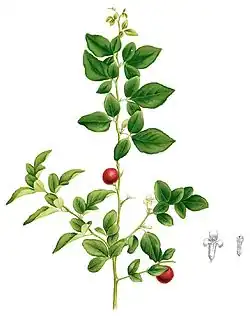Triphasia
| Triphasia | |
|---|---|

| |
| Triphasia trifolia foliage and fruit | |
| Scientific classification | |
| Kingdom: | Plantae |
| Clade: | Tracheophytes |
| Clade: | Angiosperms |
| Clade: | Eudicots |
| Clade: | Rosids |
| Order: | Sapindales |
| Family: | Rutaceae |
| Subfamily: | Aurantioideae |
| Genus: | Lour. |
| Species | |
|
See text. | |
| Synonyms[1] | |
| |
Triphasia is a small genus of flowering plants, comprising three species, in the family Rutaceae.[1][2] The genus is related to Citrus and is native to southeastern Asia and New Guinea.[3][4]
They are evergreen shrubs growing to 1–3 m tall, with trifoliate leaves. The flowers are fragrant, white, with three to five petals. The fruit is an edible red hesperidium similar to a small Citrus fruit.[4][5]
- Species
- Triphasia brassii (C.T.White) Swingle – New Guinea
- Triphasia grandifolia Merr. – Philippines
- Triphasia trifolia (Burm.f.) P.Wils. – Malaysia
References
- ^ a b "Triphasia Lour". Plants of the World Online. The Trustees of the Royal Botanic Gardens, Kew. n.d. Retrieved July 3, 2025.
- ^ "Triphasia Lour". Catalogue of Life. Species 2000. n.d. Retrieved July 3, 2025.
- ^ Germplasm Resources Information Network: Triphasia Archived 2015-09-24 at the Wayback Machine
- ^ a b Huxley, A, ed. (1992). New RHS Dictionary of Gardening 3: 697. Macmillan ISBN 0-333-47494-5.
- ^ Plants for a Future: Triphasia trifolia